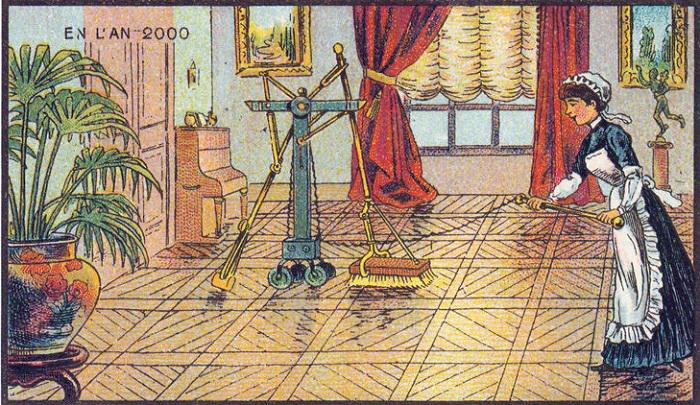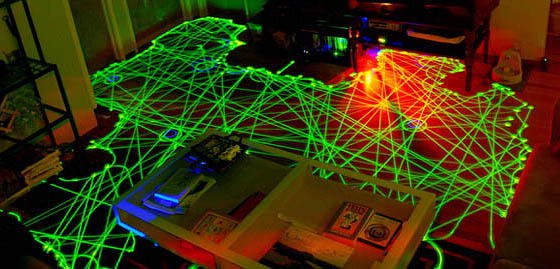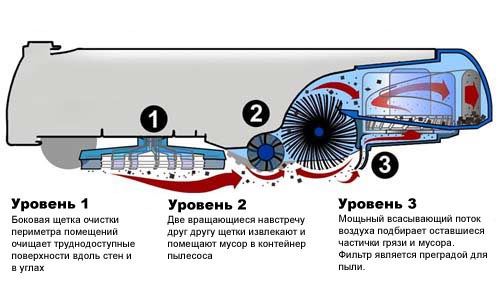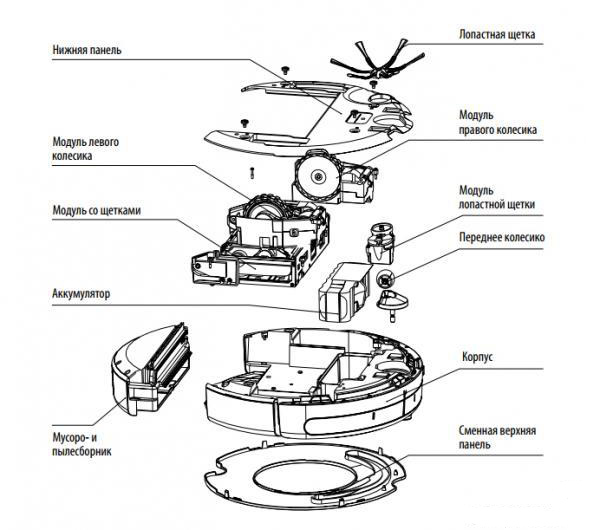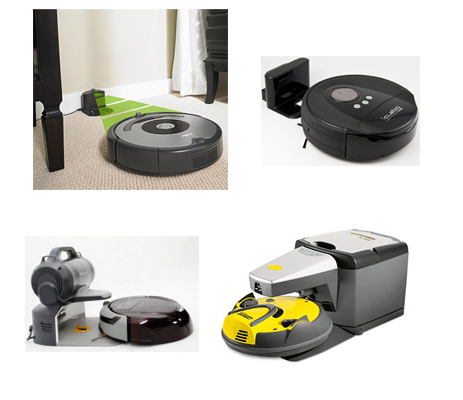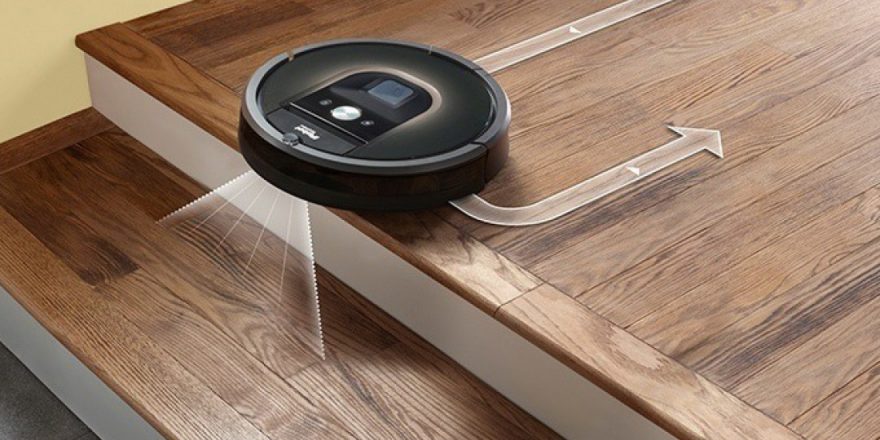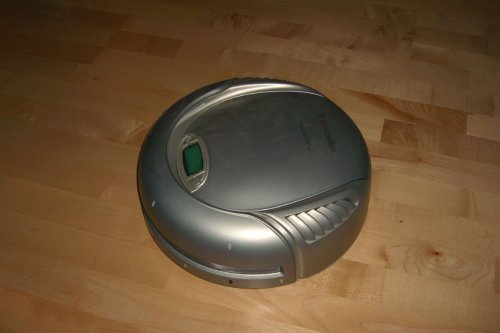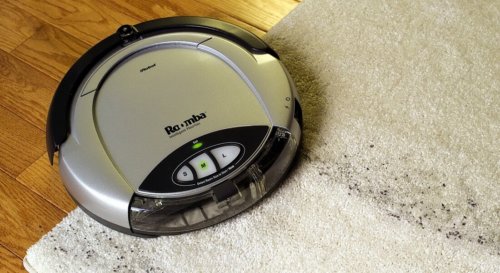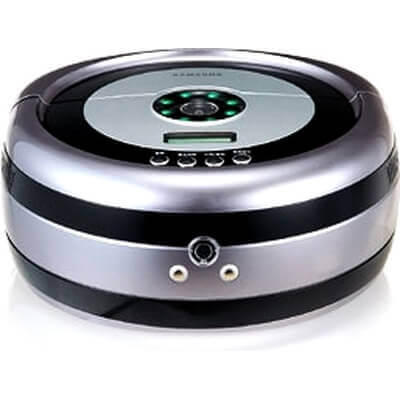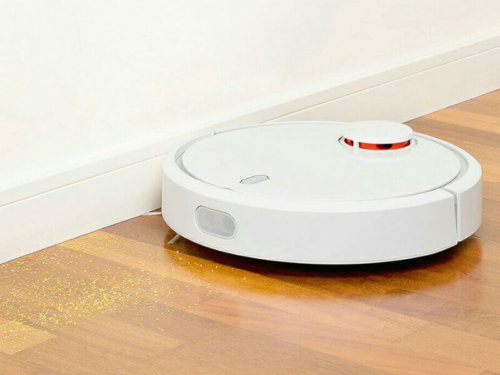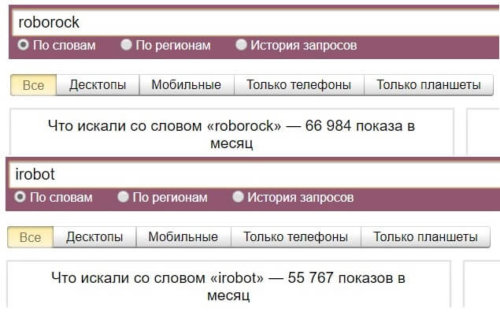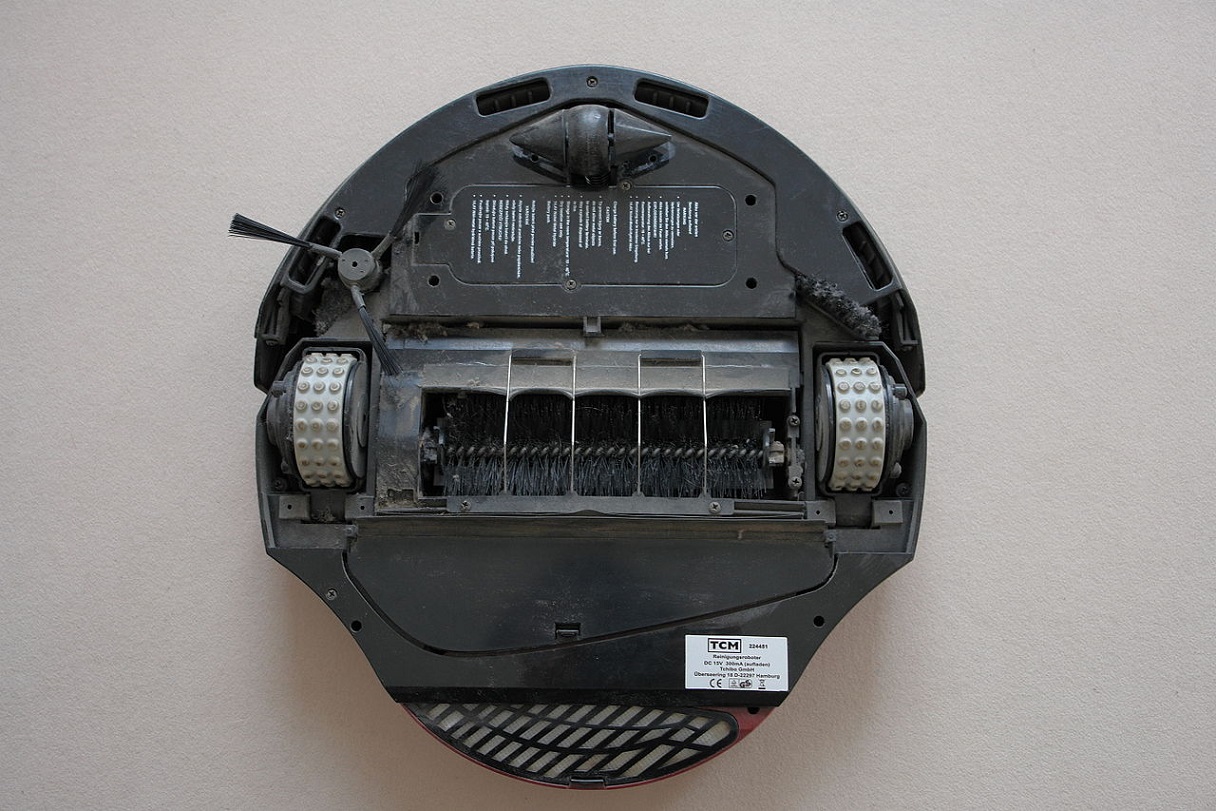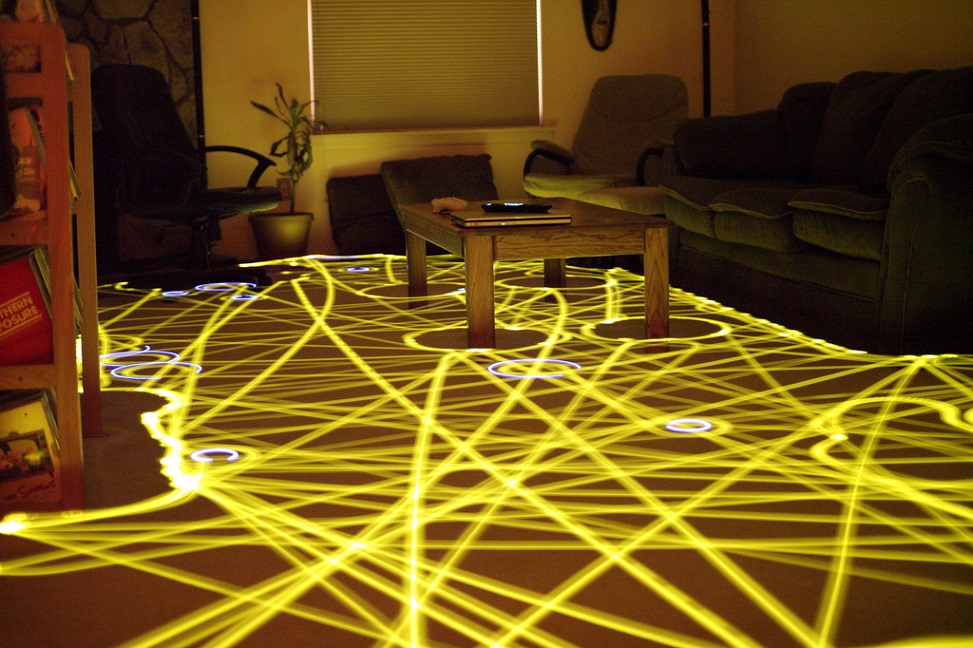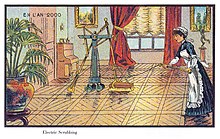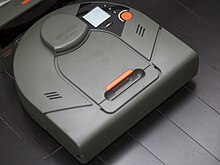Концепция роботов-пылесосов еще много лет назад появилась на страницах книг некоторых авторов. В середине 20 века в одном из журналов был напечатан роман «Дверь в лето» американского писателя-фантаста Хайнлайма. Главными действующими лицами произведения являются талантливые изобретатели роботехники. Уже в 1956 году автор произведения упоминает «Ловкого Фрэнка» — аппарат, который помогает в уборке по дому.
История появления роботов-пылесосов
(Французский художник Жан-Марк Коте в 1899 году создал зарисовки из серии «какой будет жизнь в будущем»)
Однако, в реальной жизни такие «умные помощники» появились примерно через полвека. В 1997 году в одной из передач BBС телезрители узнают о последней новинке в области техники и электроники: роботе-пылесосе. Уникальный прибор был представлен Шведской компанией Electrolux и завоевал всеобщее внимание. Несколько позже свои аналоги выпустила «IRobot Corporation». Эти первые машины относятся к роботам-пылесосам первого поколения. Роботы имели достаточно много недостатков, однако, их изобретение и выход на рынок уже было прорывом.
Начиная с 2004 года компании — производители начали выпускать роботы-пылесосы второго поколения. От приборов первого поколения они отличались более совершенной конструкцией, расширенным функционалом и большим удобством для потребителя. В 2005 году компания Siemens представила своим потребителям робот-пылесос второго поколения «Sensor Cruiser». В 2004 Electrolux выпустил свои усовершенствованные «Triobite» (2.0) второго поколения.
После 2004 года список компаний, производящих «умные» пылесосы значительно расширился. Karcher, Applica, Samsung, LG и другие компании начали выходить на этот перспективный рынок.
В России «умные» пылесосы появились лишь в 2009 году. Продукция была адаптирована под российский рынок, получила необходимые сертификаты.
Принцип работы
Функционирование «умного» пылесоса обеспечивают следующие основные системы: навигационный модуль, чистящий, механизм поиска базы и подзарядки.
- Система навигации позволяет вашему «умному помощнику» ориентироваться в доме. Корректная работа этой системы не позволяет роботу заблудиться или где-то не убраться. Выделяют основные разновидности навигационных модулей, которые предлагают разные производители: датчики робота; внешние датчики; лазер; камера.
- Чистящий модуль отвечает непосредственно за очищение поверхностей в квартире. Если системы навигации у разных производителей могут значительно отличаться, то устройство чистящего модуля у всех примерно одинаково. Стандартная схема уборки «умного» пылесоса: при движении робота щетка, расположенная сбоку, собирает грязь и сметает ее под основную щетку. Основная щетка в свою очередь собирает пыль, грязь и подбрасывает в сторону пылесборника, где ее уносит потоком воздуха. Принцип уборки у «умных» пылесосов разных производителей примерно одинаков. Различия могут быть лишь в количестве основных или боковых щеток, фильтрах, а также в мощности и вместительности пылесборников.
- Механизм поиска базы и подзарядки. В роботе – пылесосе установлен аккумулятор, который дает прибору необходимый запас энергии для работы. Если аккумулятор разряжается, то робот выключается. Именно поэтому при снижении уровня зарядки до определённого уровня, в роботе включается режим поиска базы для дальнейшей подзарядки. Роботы-пылесосы, оснащенные различными навигационными системами (камеры, лазеры), запоминают свой путь и без труда сами находят базу.
Устройство робота-пылесоса
Щетки
Важнейшим элементом робота пылесоса являются щетки. Как правило, в современных автоматических уборщиках установлены два вида щеток: основные и боковые. У пылесоса может быть одна или две основные щетки. Щетки двигаются по направлению друг к другу и собирают загрязнения. Боковые щетки находятся на нижнем краю устройства. Они отвечают за уборку в углах, а также вдоль плинтуса.
При выборе робота-пылесоса стоит обратить внимание на материал, из которого сделаны щетки. Щетки из жесткого ворса прослужат вам намного дольше, чем щетки из лески.
Пылесборник
Находится внутри пылесоса. Объемы пылесборника могут варьироваться от минимальных и до 1 л. Пылесосы с маленьким пылесборником подойдут для уборки не больших помещений, в которых нет животных. Если площадь вашего жилья более 40 кв. м. и в квартире есть домашние животные, то лучше выбирать пылесос с более объемным пылесборником.
Фильтр
Один из элементов «умного» пылесоса – фильтры. Лучше всего приобретать приборы с многослойными фильтрами.
Аккумулятор
Как правило, роботы-пылесосы оснащены следующими типами аккумуляторов: никель-металлогидридные и литий-ионные. Последний тип аккумуляторов считается более долговечным, прибор с таким аккумулятором может работать до 3 часов от одной зарядки.
Датчики
Помогают пылесосу ориентироваться в доме. Датчики могут быть трех видов: инфракрасные, ультразвуковые, лазерные. Чем выше стоимость аппарата, тем большее количество датчиков он имеет.
Виды роботов-пылесосов
Роботы-пылесосы можно условно классифицировать по нескольким основным признакам.
По выполняемым функциям выделяют:
- Устройства для сухой уборки
- Устройства, выполняющие как сухую, так и влажную уборку
По объему работ принято выделять:
- Пылесосы с маленьким радиусом использования
- Пылесосы с большим радиусом работы
По стоимости:
- Не дорогие модели (до 15 т. р.). Не отличаются мощностью, высоким качеством работы и долгим зарядом. Можно использовать для уборки не больших квартир и помещений.
- Средний ценовой сегмент (15-40 т. р.). В данной группе представлены качественные многофункциональные пылесосы с мощным аккумулятором, хорошим объемом пылесборника и датчиками.
- Дорогие модели. К данной группе относят пылесосы элитного сегмента. Они не сильно отличаются от аппаратов средней ценовой категории, однако, могут иметь полезные эксклюзивные функции (например, голосовые команды).
За и против
Стоит ли покупать робот-пылесос? Нужен ли он? Не будет ли покупка бесполезной тратой денег? Безусловно, на эти вопросы вы должны ответить себе сами.
Однако, мы напомним вам основные аргументы ЗА и ПРОТИВ покупки робота-пылесоса.
Аргументы ЗА:
- Экономит время. Особенно при наличии большой квартиры, которую необходимо долго убирать.
- Убирает не только пыль и грязь, но еще и шерсть домашних животных
- Возможность уборки в труднодоступных местах: под шкафами, столами, диванами
- Незаменимый помощник в уборке, если дома есть аллергики. Помогает всегда поддерживать квартиру в чистоте.
Аргументы ПРОТИВ:
- Высокая стоимость
- Могут возникнуть проблемы с сигнализацией, установленной в доме. Сигнализация может срабатывать в ответ на передвижения робота.
- Менее тщательная уборка в углах квартиры и труднодоступных для робота местах.
- Невозможность уборки пола под низко стоящей мебелью.
- Робот-пылесос не способен справиться с сильными загрязнениями: прилипшая к полу еда или напитки. Такие загрязнения все равно придется устранять в ходе влажной ручной уборки.
Счастья вам, радости, здоровья, делайте все как положено и храни Господь!
10 ноября 2016
3374
Сказка про робот-пылесос
Один мальчик очень любил есть не за столом, а за маленьким журнальным столиком в гостиной, около телевизора. Он брал свежую булочку, чашечку кофе, масло, джем, апельсиновый сок, омлет, садился в восемь утра и начинал есть. Так как он ел не за столом, а за столиком, то повсюду были крошки. И девочка этого мальчика постоянно его пилила, мол, ну что же ты все крошишь батон свой. Ну возьми пылесос и убери. А пылесос был далеко, на балконе, в двух метрах — где-то в бесконечности. Доставали его раз в неделю навести порядок. Так что мальчик аккуратно ножкой закидывал крошки под диван и уходил восвояси.
А еще мальчик очень любил свою бороду. Ровнял ее триммером в ванной, умасливал, ухаживал. Как вы понимаете, вокруг раковины были волосы. Немного. Мальчик аккуратно старался все убрать специальной щеткой, но ничего из этого не получалось. А пылесос, как вы знаете, стоял Бог его знает где. На балконе. Очень далеко.
Девочка любила кошку Машку. Кошка была красивая, с длинной шерсткой. И в квартире в комнатах можно было эту шерстку собрать и сплести из нее как минимум свитер. Потому что уж больно много с кошки Машки сыпалось шерсти. Кошка была любимая и пылесос ради нее не доставали. Так, щеткой старались убирать.
В один прекрасный день мальчик и девочка поняли, что как-то очень много скапливается в квартире мелкой уборки и решили попробовать робот-пылесос. Мальчик хотел что-то недорогое, на пробу. Девочка хотела недорогое и продвинутое.
Нашли пылесосы Puppyoo с забавным логотипом. Выбрали модель V-M 611-A. Вот прямо как на фото. Заказали, стали ждать. Вечером привезли коробку. В коробке лежал пылесос, зарядная станция, какие-то щетки, пульт ДУ, фильтры и что-то еще. Что удивило мальчика и девочку, так это ум робота-пылесоса.
Стоило включить док-станцию в сеть и опустить робота на пол, как он тут же стал искать зарядку, нашел и встал на прикол. То есть, стал заряжаться, мигнув индикаторами. Пока заряжался, мальчик и девочка читали интересные технические характеристики:
Размер корпуса: диаметр 31 см, высота 7,7 см
Напряжение: AC 100-240 В, 50/60 Гц
Батарея: 2200 мАч
Время зарядки: 6 часов
Зарядка: при автоматическом возврате на базу или подзарядка вручную
Емкость пылесборника: 0,25 л
Вес корпуса: 1,8 кг
Время уборки: до 120 мин
Уровень шума: ниже 60 Дб
Функция преодоления препятствий: высота до 7 мм.
Особенности: Четырехуровневая система фильтрации надежно запирает пыль изнутри и предотвращает от возможного попадания частиц в воздух. Пылесборник легко очищается и моется, антибактериальная сетка задерживает гранулы до 0,35 мм, фильтрующая трубка задерживает до 99,97% пыли и микронасекомых, запатентованный фильтр HEPA задерживает частицы 0,1-0,3 микрона, в том числе и пыльцу. Датчик предотвращения столкновения срабатывает в 2,5 см от предмета.
Пылесос выглядит как и положено роботу-пылесосу. Круглый, плоский, зарядная станция не занимает много места, да и пылесос тоже. Батарея позволяет убираться более часа, после этого робот начинает искать док-станцию для зарядки. Пылесборник вроде бы маленький, но мальчик и девочка решили по этому поводу не переживать и посмотреть, что будет. Кошке тоже было очень интересно. Она нюхала пылесос и даже пыталась на него забраться — робот пискнул, кошка Машка убежала.
После зарядки началась потеха. Ребята решили посмотреть, что будет проверили пылесборник, поставили вниз две щетки, внимательно изучили пульт ДУ. С его помощью можно управлять роботом в полной объеме, если есть прямая видимость. Например, выбрать время уборки, управлять движением, вернуть на зарядную станцию.
Штука полезная. А продвинутые мальчики смогут обучить робота подчиняться ИК-порту в самых разных смартфонах. Это если есть желание. Под открывающейся крышкой находится емкость для пыли, в комплекте есть щеточка для чистки. Рядом с ней кнопка включения, не забудьте нажать. Ну что, начнем, спросил мальчик? Кошка Машка и девочка сказали да. Пылесос пискнул и поехал.
Шума от робота не сказать, что много, но шум, конечно, есть. Другой вопрос, что если все ушли на работу и пылесос катается в пустой квартире — то пускай катается. Кошка Машка как раз разомнется, убегая от заботливого прибора. Не забудьте, что док станцию нужно расположить в относительно свободном месте, чтобы слева и справа было около метра места, ну и чтобы место было темное, спокойное. Лучше у стены.
В общем, стали смотреть. Робот жадно убрал все крошки вокруг журнального столика даже залез под диван, благо, толщина позволяет. Пошуршав там, вылез наружу, явно с недовольным видом. Мол, хозяева, ну вы что, давайте шваброй теперь поработайте. Стал ездить по гостиной. Ездил-ездил, нашел вход в коридор. Там забрал кошкины волосы. Проехал в ванную. Лучше коврики заранее убрать. Хотя, может проехать. В ванной засосал все волоски и кошкин пух по углам. Поехал дальше, на кухню. Отлично! Заехал под кровать в спальне.
Пыль там, видимо, была, так сказал мальчик девочке, опустошая полный пылесборник. «Вот тебе и Puppyoo!» — так ответила девочка, радуясь, что ей теперь не придется идти за пылесосом на далекий балкон.
Ну а мальчик порадовался, что батарею в пылесосе при необходимости можно заменить, щетки съемные и легко чистятся, фильтры снимаются и меняются. И размер невелик, летом можно кинуть в багажник, отвезти на дачу — пусть там ездит и собирает крошки. Почему бы и нет?
Вот так мальчик и девочка решили проблему с крошками, кошкиными волосками и другим мелким мусором, скапливающимся в наших квартирах ежедневно. Современно, изящно и делать ничего не надо. Только купить робот-пылесос Puppyoo V-M 611-A, который продают по акции со скидкой 11 ноября, вот ссылка и купон со скидкой.
На правах рекламы

В 2020 году роботы-пылесосы уже не являются чем-то футуристичным, их можно встретить на витринах большинства сетевых магазинов, а также в современных домах и квартирах. Новые бытовые роботы оснащены искусственным интеллектом, благодаря чему способы автономно убирать всю доступную площадь жилья и тем самым экономить свободное время хозяев. Роботы-пылесосы составили весомую конкуренцию обычным пылесосам и вертикальным, хотя с последними их все же желательно комбинировать для точечной доуборки труднодоступных мест (например, ступеньки лестниц). Самое интересное, что данный вид бытовой техники появился на рынке для свободной продажи относительно недавно, меньше чем 20 лет назад. В пределах данной статьи редакцией сайта Robotobzor будет рассмотрена история создания роботов-пылесосов и их эволюция до сегодняшнего дня.
Итак, если не брать в расчет упоминания в фантастических романах, на практике все началось с 1996 года, когда на телеканале BBC зрителям продемонстрировали прототип первого робота-пылесоса от компании Electrolux. Немногим позже, в 2001 году был выпущен первый в мире робот-пылесос Electrolux Trilobite, серийный выпуск которого начался с 2002 года. Это был уникальный автоматический пылесос, который дал толчок к активному развитию данного вида бытовой техники.
Electrolux Trilobite
В этом же 2002 году инициативу перехватили будущие лидеры рынка (до определенного момента времени), американская компания iRobot. Они продемонстрировали свой первый робот-пылесос для сухой уборки (серия Roomba), который поступил в продажу только в 2004 году. Кстати, сама компания iRobot основана в 1990 году, но до производства бытовых роботов производство было сфокусировано на робототехнике для военного ведомства и космической программы NASA.
Первый iRobot Roomba
В 2004 году первооткрыватели, компания Electrolux, представили на рынке обновленную модель Electrolux Trilobite 2.0. В это же время на рынке появились новые участники, а точнее роботы-пылесосы от именитых брендов. Свои разработки анонсировали корейские компании LG (LG ROBOKING) и Samsung (Samsung VC-RP30W), а также немецкий робот-пылесос RoboCleaner RC 3000 от Karcher и Sensor Cruiser от Siemens.
Samsung VC-RP30W
2005 год стал более интересным и переломным, т.к. на рынке появились новые популярные бренды, которые успешно конкурируют и по сей день. Это американские Neato Robotics (основаны в 2004 году) и корейские iClebo.
2006 год стал не менее ключевым в истории роботов-пылесосов. Компания ECOVACS Group, основанная еще в 1998 году, создает подразделение ECOVACS ROBOTICS, которое специализируется на производстве бытовых роботов для уборки: роботов-пылесосов и мойщиков окон. По сей день продукция компании Ecovacs славится хорошим качеством уборки и передовым функционалом.
После 2006 года на рынке начали появляться многие китайские производители роботов-пылесосов, а также свои разработки анонсировали такие именитые бренды, как Infinuvo, Dyson, Hitachi, Panasonic и др. Только Dyson действительно заработал должный успех, создав позже один из самых мощных роботов-пылесосов Dyson 360 Eye (в 2015 году, но разработка заняла больше десяти лет).
Если говорить о истории развития роботов-пылесосов в России, то тут несколько ключевых моментов:
- В 2009 году на российском рынке появились Айроботы на официальном уровне.
- В 2010 году появляются первые модели компании Xrobot (Китай).
- В 2011 году стартовали продажи первых роботов-пылесосов компании Clever&Clean.
- С 2012-2014 года появляются такие бренды, как Panda, Okami, Gutrend, iBoto, Genio, Hobot и др. В это же время рынке дебютировали iLife – одни из самых продаваемых китайских роботов-пылесосов в бюджетном сегменте.
- 2016 год – переломный момент в истории роботов-пылесосов. В сентябре 2016 года был выпущен первый робот-пылесос компании Xiaomi (модель Xiaomi Mi Robot Vacuum Cleaner), который буквально перевернул рынок. Интерес к этой модели появился из-за ее оптимальности во всех пониманиях: навигация на базе лидара, управление через приложение, высокая мощность всасывания, центральная щетка и цена не выше 300$.
Xiaomi Mi Robot Vacuum Cleaner
После 2016 года компания Xiaomi выпустила более десяти роботов-пылесосов разного назначения и ценового сегмента. Интересно то, что на сегодняшний день популярность роботов-пылесосов Сяоми (если брать во внимание только модели компании Roborock) превысила лидеров iRobot, которые с 2010 года не имели серьезных конкурентов. Для подтверждения этого факта прикрепляем данные известного сервиса Яндекс.Вордстат (сравнение популярности запроса):
Xiaomi vs iRobot
Как вы видите, за последний месяц «Робороком» поинтересовалось почти 67 тыс. человек, в то время как «Айроботами» не более 56 тыс. человек. Интерес вызван множеством факторов: цена продукции, функционал и отзывы о моделях.
Также с 2016 года на рынке появились первые роботы-полотеры компании Everybot.
В 2019 году свой первый робот-пылесос анонсировала компания Lenovo (Lenovo X1) и Narwal (Narwal T10). Говоря о последнем, Narwal T10 – это первый в мире моющий робот-пылесос с базой для самоочистки. Наверняка он станет одним из самых интересных роботов, когда стартует серийное производство и появление первой партии на российском рынке.
На февраль 2020 года никаких сенсаций не было анонсировано. Как всегда ждем новые флагманы от Xiaomi, iRobot и других известных брендов.
Робот пылесос представляет собой автономный роботизированный пылесос, который имеет интеллектуальное программирование и ограниченную систему вакуумной очистки.
Первоначальная конструкция включала ручное управление с помощью дистанционного управления и режим «самостоятельного привода», который позволял машине автономно чистить без контроля человека.
В некоторых конструкциях используются вращающиеся щетки для достижения плотных углов. Другие сочетают в себе ряд функций очистки (вытирание, УФ-стерилизация и т. д.)
одновременно с всасыванием пыли, что делает машину нечто большим, чем просто роботом-пылесосом.
Первый робот пылесос Electrolux Trilobite был создан шведским производителем бытовой и профессиональной техники Electrolux. Electrolux удалось приобрести модель у своего изобретателя Джеймса Дайсона. В 1996 году одна из первых версий пылесоса Electrolux Trilobite была представлена в научной программе BBC «Мир завтрашнего дня». [1]
В 2001 году британская технологическая компания Dyson построила и продемонстрировала робота, известного как DC06. Однако из-за его высокой цены он никогда не выпускался на рынок.
В 2002 году американская компания по передовым технологиям iRobot запустила робота для уборки пола Roomba. Первоначально iRobot решил произвести 15 000 единиц и еще 10 000 единиц в зависимости от успеха запуска. Roomba сразу стал огромной потребительской сенсацией. К рождественскому сезону iRobot выпустил 50 000 единиц, чтобы удовлетворить спрос на праздник. После этого успеха, основные специализированные розничные торговцы, а также более 4000 торговых точек, таких как Target, Kohl’s и Linens ‘n Things, начали продавать Roomba.
С 2002 года на рынке появились новые вариации роботизированных пылесосов. Например, канадский робот пылесос bObsweep, который как мопс, так и пылесос, или роботизированный пылесос Neato Robotics XV-11, который использует лазерное зрение, а не традиционные ультразвуковые датчики.
В 2014 году Дайсон объявил о выпуске своего нового роботизированного пылесоса под названием Dyson 360 Eye, оснащенного камерой на 360 градусов, которая установлена на верхней части пылесоса робота и должна обеспечивать лучшую навигацию, чем другие марки. Релиз пылесоса был запланирован на выпуск только в Японии весной 2015 года с международными запусками, которые последуют в следующем году. Более того, Дайсон объявил, что 360 Eye всасывает в 2 раза сильнее любого другого робота пылесоса. Дайсон возглавляет рынок роботизированных пылесосов. Компания инвестирует в робототехнику, ИИ и в производство лучших роботов-пылесосов в ближайшие годы. Он приступил к созданию нового кампуса в Великобритании, для чего потребуется около 7000 рабочих мест и инвестиций в размере 330 млн. Фунтов стерлингов для создания более широкого исследовательского объекта в Сингапуре с упором на «связанные технологии и интеллектуальные машины».
По состоянию на 2016 год 20% пылесосов являются роботами.
По состоянию на 2017 год 23% пылесосов являются роботами.
A cleaning robot from 2006
A robotic vacuum cleaner, sometimes called a robovac or a roomba as a generic trademark, is an autonomous robotic vacuum cleaner which has a limited vacuum floor cleaning system combined with sensors and robotic drives with programmable controllers and cleaning routines. Early designs included manual operation via remote control and a «self-drive» mode which allowed the machine to clean autonomously.[1] Some designs use spinning brushes to reach tight corners, and some include a number of cleaning features along with the vacuuming feature (mopping, UV sterilization, etc.).[2] More recent models use artificial intelligence and deep learning for better mapping, object identification and event-based cleaning.
Marketing materials for robotic vacuums frequently cite low noise, ease of use, and autonomous cleaning as main advantages.[3] The perception that these devices are set-and-forget solutions is widespread but not always correct. Robotic vacuums are usually smaller than traditional upright vacuums, and weigh significantly less than even the lightest canister models. However, a downside to a robotic vacuum cleaner is that it takes an extended amount of time to vacuum an area due to its size. They are also relatively expensive,[4] and replacement parts and batteries can contribute significantly to their operating cost.[5]
History[edit]
Retrofuturistic illustration of an «electric scrubber» in the year 2000, as envisaged by an artist in 1899
In 1956, the American science fiction author Robert A. Heinlein described the concept of a robotic vacuum cleaner with a recharging dock in his novel The Door into Summer: «Basically it was just a better vacuum cleaner …. It went quietly looking for dirt all day long, in search curves that could miss nothing …. Around dinner time it would go to its stall and soak up a quick charge.»[6]
In 1969 on 2 April an episode of The Avengers was broadcast in which the character Inge Tilson played by Dora Reisser says «…I saw a demonstration once. A robot vacuum cleaner. It swept around the house, went back into its cupboard, automatically plugged in and recharged itself…». The teleplay for this episode which was entitled «Thingumajig» was written by Terry Nation. It was episode 27 of Season 7.[7]
In 1985, Tomy released the Dustbot as a part of their Omnibot line of toys. Dustbot is the first robot to feature a built in vacuum. He vacuums dust, crumbs and pieces of paper as he moves, turning whenever he senses an edge or runs into something. Dustbot would carry a mini broom and dustpan for decoration and move the broom as he moves. Later robot vacuums improve upon the technology of the Dustbot but lack the charm of a toy robot with a broom. [8][9][10]
In 1990, three roboticists, Colin Angle, Helen Greiner, and Rodney Brooks, founded iRobot.[11] It was originally dedicated to making robots for military and domestic use. It launched the Roomba in 2002, which was able to change direction when it encountered an obstacle, detect dirty spots on the floor, and identify steep drops to keep it from falling down stairs.[5] The Roomba proved to be the first commercially successful robot vacuum.[12] In 2005, iRobot introduced the Scooba, which scrubbed hard floors.
In 1996, Electrolux introduced the first “Robotic Vacuum Cleaner”, the Electrolux Trilobite.[5] It worked well but had frequent problems with colliding with objects and stopping short of walls and other objects, as well as leaving small areas not cleaned.[5] As a result, it failed in the market and was discontinued.[5] In 1997, one of Electrolux’s first versions of the Trilobite vacuum was featured on the BBC’s science program, Tomorrow’s World.[13]
In 2001, Dyson built and demonstrated a robot vacuum known as the DC06. However, due to its high price, it was never released to the market.[14] Electrolux Released the Trilobite robotic vacuum cleaner. The Robotic vacuum cleaner launched at a price of $1,800.00. There were two models: The ZA1 and the ZA2.
In 2010, the Neato Robotics XV-11 robotic vacuum introduced laser based mapping, allowing navigation in straight lines rather than the traditional random navigation.[15]
In 2015, Dyson and iRobot both introduced camera based mapping.[16][17]
In 2016, iRobot CEO claimed that 20% of vacuum cleaners sales worldwide were robots.[18]
As of 2018, obstacles such as dog feces, cables and shoes remain very difficult for robots to navigate around.[19][20]
In 2022, ECOVACS launched DEEBOT-X1 Family featuring YIKO[21] Voice Assistant, the industry’s first natural language for home robots with Al voice interaction technologies, including voice semantics from Google, you can control DEEBOT with the power of your voice[22][23][24]
Main features[edit]
Cleaning modes[edit]
A cleaning robot as seen from below
Robotic vacuum has different types of cleaning modes, usually include the following:[25]
- Auto: This mode is helpful for general cleaning. Usually, the mode cleans a space until the battery runs out.
- Spot: with the help of this mode, the vacuum focus on a particular dirty zone.
- Turbo: This mode is used to clean and pick up the most dirt and dust, but it may create noise.
- Edge: This mode helps to clean edges & corners.
- Quiet: The mode helps to reduce noise levels while cleaning. It’s helpful when you are at home.
- Remote control: It allows the user to control the direction of the vacuum.
Wet mopping[edit]
Some models can also mop for wet cleaning, autonomously vacuuming and wet-mopping a floor in one pass (sweep and mop combo).
The mop is either manually wet before attachment to the bottom of the robot or the robot may be able to automatically spray water on to the floor before running over it.
Some advanced robot vacuum cleaners have a sensor that detects and avoids mopping in carpeted areas. However, if there is no sensor, most of the robot vacuum cleaner manufacturers add a no-mop zone feature in the app to make robot vacuums to avoid certain areas from mopping. These robot vacuums are also capable to mop about 150sqm in one go.
A Robot Mop can tackle multi surfaces and comes with a variety of different cleaning modes giving you options of sweeping, vacuuming and mopping damp or wet floors. The Robot Mop score better on hard floors surface and are ideally suited for hardwood, laminate and tile flooring types.
Mapping[edit]
The first robovacs used random navigation. This sometimes caused the unit to miss spots when cleaning or be unable to locate its base station to recharge, and did not provide the user a history of which spaces were cleaned.
More sophisticated models include mapping ability. The unit can use gyro, camera, radar, and laser (laser distance sensor or LDS) guided systems to create a floor plan, which can be permanently stored for more efficiency, and updated with information on areas which have been (or have not been) cleaned. Thus, the cleaning efficiency is greatly improved and the repetition rate is reduced significantly.
Models with a multiple floor plan feature can store several floor plans.
Others[edit]
- Antidrop
- Most robots include anti-drop and anti-bump IR sensors.
- Anti-winding
- When approaching obstacles, will automatically turn away.
- Antitwining
- Prevents the robot getting twined by wires.
- Virtual No-Go lines
- Virtual No-Go lines set boundaries, to restrict the unit’s movements to desired cleaning areas.
- Quick recharge
- Most robot vacuums come with a Lithium ion battery of around 2000 mAh that will last long enough to handle approximately 200 m2 of floor space (about 100 minutes). Regular charge time is 5 to 6 hours. Quick recharge allows the unit to calculate the shortest way to recharge (shortcut path) and charge only as much as needed, so it finishes more quickly (automatic cleaning resumption).
- Schedule
- Scheduled daily cleaning. All-Timetable means a full week of different daily schedules can be programmed.
- Connected app
- Some models allow control of the unit using an app over a WiFi connection, from your smartphone or connected home automation device, e.g. Amazon Alexa and the Google Assistant.
- Software upgrades
- Some units are able to receive over the air (OTA) firmware updates.
- HEPA Filters
- HEPA air filters are industry standard now for robot vacuum cleaners. These remove dust and pollen from the air.
List of robotic vacuum cleaners[edit]
- Electrolux Trilobite — 1996. Named for its appearance, basic functionality and mild functional success. Introduced the public to the concept. Discontinued.[5]
- LG Roboking — launched in 2001
- Dyson DC06 — 2001. Deemed too expensive; not released.[5]
- iRobot Roomba — 2002. Basic features on this early iRobot model succeeded in defining the retail category in America.[5]
- Kärcher RC3000 and RC4000 — sold from 2002 to 2015
- Friendly Vac RV400 — 2004, from Hoover and Friendly Robotics (Robomow); discontinued
- Koolvac — all U.S. models destroyed in 2005 due to a successful patent infringement lawsuit by iRobot
- Ecovacs Robotics Deebot series — introduced in 2007
- iRobot Pet Series — 2008.[26]
- Dustbot — prototype for street cleanup, 2010
- Neato Robotics XV-11 — 2010.[27] The Neato had average specifications for its time but implemented a laser mapping system.[15][28]
- iRobot Roomba 980 — 2015. iRobot implements camera mapping, a wifi module, and a smartphone app.[17]
- Dyson 360Eye — 2015. Marketed as Dyson’s «first» robotic vacuum, this model included camera-based obstacle detection and room mapping.[16]
- iRobot Roomba i7 Plus with Clean Base — 2018.[11] The iRobot consumer lineup now self-empties, docks, and charges, enabling continuous cleaning.
- SharkNinja AI, IQ, and ION Robot Vacuums,[29] which were successfully defended against patent lawsuits by iRobot[30]
Open source designs[edit]
These are open source designs that can be built using off-the-shelf components and 3D printed parts.
- MARK II — released 2019[31]
- Cesnietor VacuumRobot — released 2017[32][33]
See also[edit]
- Automated pool cleaner
- Comparison of domestic robots
- Domestic robots
- List of vacuum cleaners
- Mobile robot
- Open-source robotics
- Robotic mapping
- Wireless sensor network
References[edit]
- ^ ilumpruj (2018-06-24). «The History of Robot Vacuum Cleaner». Retrieved 2021-05-12.
- ^ «Best Robot Vacuum Cleaners». Decoding. 2021-01-16. Retrieved 2021-01-27.
{{cite web}}: CS1 maint: url-status (link) - ^ «10 Benefits of Owning a Robot Vacuum 2020». Best Robot Vacuums 2020. 2019-12-16. Retrieved 2020-01-16.
- ^ «How Robotic Vacuums Work». How Stuff Works. Retrieved 2018-03-05.
- ^ a b c d e f g h «Invention of Robotic Vacuum Cleaners». Vacuum Cleaner History. Retrieved 2018-03-05.
- ^ Heinlein, Robert A (1957). The Door into Summer. New York: Signet. pp. 20–21.
- ^ «The Avengers Thingumajig (TV Episode 1969)».
- ^ «The Old Robots Dustbot».
- ^ «1985 Tomy Dustbot Japanese».
- ^ «Dustbot Robot».
- ^ a b «the history of the roomba».
- ^ Bennett, Brian. «Why are iRobot’s new Roombas so damn expensive?». CNET. Retrieved 2020-05-17.
- ^ «BBC NEWS — Technology — Robot cleaner hits the shops».
- ^ Ulanoff, Lance. «Dyson Wants to Build a Robot Vacuum that Can See».
- ^ a b «Neato XV-11 robotic vacuum review». Engadget. August 24, 2010. Retrieved 2020-05-17.
- ^ a b «Deluxe brand Dyson creates its first robot vacuum, the 360 Eye». 2014-09-04. Retrieved 2015-09-26.
- ^ a b «iRobot Brings Visual Mapping and Navigation to the Roomba 980». IEEE Spectrum: Technology, Engineering, and Science News. 16 Sep 2015. Retrieved 2020-05-17.
- ^ «iRobot says 20 percent of the world’s vacuums are now robots». TechCrunch. Retrieved 2020-05-17.
- ^ Solon, Olivia (2016-08-15). «Roomba creator responds to reports of ‘poopocalypse’: ‘We see this a lot’«. The Guardian. ISSN 0261-3077. Retrieved 2020-05-17.
- ^ Bryan Heater (2017-12-06). «PerceptIn has raised $11 million to help robotic vacuums and self-driving cars see». TechCrunch. Retrieved 2018-05-25.
- ^ «DEEBOT X1 Family | New Arrival All in One Vacuum and Mop». ECOVACS US. Retrieved 2022-11-25.
- ^ [,https://au.pcmag.com/robot-vacuums/93621/ecovacs-launches-the-deebot-x1-range-of-robot-vacuums-mops-in-australia ,https://au.pcmag.com/robot-vacuums/93621/ecovacs-launches-the-deebot-x1-range-of-robot-vacuums-mops-in-australia]. ;
- ^ ECOVACS. «WELCOME TO THE HANDS-FREE FUTURE: ECOVACS’ NEW FLAGSHIP PRODUCT, THE DEEBOT X1 OMNI, IS NOW AVAILABLE FOR PURCHASE». www.prnewswire.com. Retrieved 2022-11-18.
- ^ «DEEBOT X1 Family | New Arrival All in One Vacuum and Mop». ECOVACS US. Retrieved 2022-11-18.
- ^ Jones, Andy. «10 best robot vacuum cleaners – how to pick between Dyson and Eureka». inews.co.uk. Retrieved 27 October 2020.
- ^ «History | iRobot». www.irobot.com. Retrieved 2021-05-12.
- ^ «Amazon.com — Neato XV-11 All Floor Robotic Vacuum System — Household Robotic Vacuums». www.amazon.com. Retrieved 2021-05-12.
- ^ «Neato XV-11 review | 22 facts and highlights». VERSUS. Retrieved 2021-05-12.
- ^ SharkNinja — Robot Vacuums
- ^ iRobot Roombas its way into Amazon’s arms
- ^ [https://www.hackster.io/news/you-can-build-this-open-source-robotic-vacuum-cleaner-43f223900712 Hackster.io —
You Can Build This Open Source Robotic Vacuum Cleaner] - ^ Instructables.com — Build your own vacuum robot
- ^ GitHub.com Cesnietor
External links[edit]
A cleaning robot from 2006
A robotic vacuum cleaner, sometimes called a robovac or a roomba as a generic trademark, is an autonomous robotic vacuum cleaner which has a limited vacuum floor cleaning system combined with sensors and robotic drives with programmable controllers and cleaning routines. Early designs included manual operation via remote control and a «self-drive» mode which allowed the machine to clean autonomously.[1] Some designs use spinning brushes to reach tight corners, and some include a number of cleaning features along with the vacuuming feature (mopping, UV sterilization, etc.).[2] More recent models use artificial intelligence and deep learning for better mapping, object identification and event-based cleaning.
Marketing materials for robotic vacuums frequently cite low noise, ease of use, and autonomous cleaning as main advantages.[3] The perception that these devices are set-and-forget solutions is widespread but not always correct. Robotic vacuums are usually smaller than traditional upright vacuums, and weigh significantly less than even the lightest canister models. However, a downside to a robotic vacuum cleaner is that it takes an extended amount of time to vacuum an area due to its size. They are also relatively expensive,[4] and replacement parts and batteries can contribute significantly to their operating cost.[5]
History[edit]
Retrofuturistic illustration of an «electric scrubber» in the year 2000, as envisaged by an artist in 1899
In 1956, the American science fiction author Robert A. Heinlein described the concept of a robotic vacuum cleaner with a recharging dock in his novel The Door into Summer: «Basically it was just a better vacuum cleaner …. It went quietly looking for dirt all day long, in search curves that could miss nothing …. Around dinner time it would go to its stall and soak up a quick charge.»[6]
In 1969 on 2 April an episode of The Avengers was broadcast in which the character Inge Tilson played by Dora Reisser says «…I saw a demonstration once. A robot vacuum cleaner. It swept around the house, went back into its cupboard, automatically plugged in and recharged itself…». The teleplay for this episode which was entitled «Thingumajig» was written by Terry Nation. It was episode 27 of Season 7.[7]
In 1985, Tomy released the Dustbot as a part of their Omnibot line of toys. Dustbot is the first robot to feature a built in vacuum. He vacuums dust, crumbs and pieces of paper as he moves, turning whenever he senses an edge or runs into something. Dustbot would carry a mini broom and dustpan for decoration and move the broom as he moves. Later robot vacuums improve upon the technology of the Dustbot but lack the charm of a toy robot with a broom. [8][9][10]
In 1990, three roboticists, Colin Angle, Helen Greiner, and Rodney Brooks, founded iRobot.[11] It was originally dedicated to making robots for military and domestic use. It launched the Roomba in 2002, which was able to change direction when it encountered an obstacle, detect dirty spots on the floor, and identify steep drops to keep it from falling down stairs.[5] The Roomba proved to be the first commercially successful robot vacuum.[12] In 2005, iRobot introduced the Scooba, which scrubbed hard floors.
In 1996, Electrolux introduced the first “Robotic Vacuum Cleaner”, the Electrolux Trilobite.[5] It worked well but had frequent problems with colliding with objects and stopping short of walls and other objects, as well as leaving small areas not cleaned.[5] As a result, it failed in the market and was discontinued.[5] In 1997, one of Electrolux’s first versions of the Trilobite vacuum was featured on the BBC’s science program, Tomorrow’s World.[13]
In 2001, Dyson built and demonstrated a robot vacuum known as the DC06. However, due to its high price, it was never released to the market.[14] Electrolux Released the Trilobite robotic vacuum cleaner. The Robotic vacuum cleaner launched at a price of $1,800.00. There were two models: The ZA1 and the ZA2.
In 2010, the Neato Robotics XV-11 robotic vacuum introduced laser based mapping, allowing navigation in straight lines rather than the traditional random navigation.[15]
In 2015, Dyson and iRobot both introduced camera based mapping.[16][17]
In 2016, iRobot CEO claimed that 20% of vacuum cleaners sales worldwide were robots.[18]
As of 2018, obstacles such as dog feces, cables and shoes remain very difficult for robots to navigate around.[19][20]
In 2022, ECOVACS launched DEEBOT-X1 Family featuring YIKO[21] Voice Assistant, the industry’s first natural language for home robots with Al voice interaction technologies, including voice semantics from Google, you can control DEEBOT with the power of your voice[22][23][24]
Main features[edit]
Cleaning modes[edit]
A cleaning robot as seen from below
Robotic vacuum has different types of cleaning modes, usually include the following:[25]
- Auto: This mode is helpful for general cleaning. Usually, the mode cleans a space until the battery runs out.
- Spot: with the help of this mode, the vacuum focus on a particular dirty zone.
- Turbo: This mode is used to clean and pick up the most dirt and dust, but it may create noise.
- Edge: This mode helps to clean edges & corners.
- Quiet: The mode helps to reduce noise levels while cleaning. It’s helpful when you are at home.
- Remote control: It allows the user to control the direction of the vacuum.
Wet mopping[edit]
Some models can also mop for wet cleaning, autonomously vacuuming and wet-mopping a floor in one pass (sweep and mop combo).
The mop is either manually wet before attachment to the bottom of the robot or the robot may be able to automatically spray water on to the floor before running over it.
Some advanced robot vacuum cleaners have a sensor that detects and avoids mopping in carpeted areas. However, if there is no sensor, most of the robot vacuum cleaner manufacturers add a no-mop zone feature in the app to make robot vacuums to avoid certain areas from mopping. These robot vacuums are also capable to mop about 150sqm in one go.
A Robot Mop can tackle multi surfaces and comes with a variety of different cleaning modes giving you options of sweeping, vacuuming and mopping damp or wet floors. The Robot Mop score better on hard floors surface and are ideally suited for hardwood, laminate and tile flooring types.
Mapping[edit]
The first robovacs used random navigation. This sometimes caused the unit to miss spots when cleaning or be unable to locate its base station to recharge, and did not provide the user a history of which spaces were cleaned.
More sophisticated models include mapping ability. The unit can use gyro, camera, radar, and laser (laser distance sensor or LDS) guided systems to create a floor plan, which can be permanently stored for more efficiency, and updated with information on areas which have been (or have not been) cleaned. Thus, the cleaning efficiency is greatly improved and the repetition rate is reduced significantly.
Models with a multiple floor plan feature can store several floor plans.
Others[edit]
- Antidrop
- Most robots include anti-drop and anti-bump IR sensors.
- Anti-winding
- When approaching obstacles, will automatically turn away.
- Antitwining
- Prevents the robot getting twined by wires.
- Virtual No-Go lines
- Virtual No-Go lines set boundaries, to restrict the unit’s movements to desired cleaning areas.
- Quick recharge
- Most robot vacuums come with a Lithium ion battery of around 2000 mAh that will last long enough to handle approximately 200 m2 of floor space (about 100 minutes). Regular charge time is 5 to 6 hours. Quick recharge allows the unit to calculate the shortest way to recharge (shortcut path) and charge only as much as needed, so it finishes more quickly (automatic cleaning resumption).
- Schedule
- Scheduled daily cleaning. All-Timetable means a full week of different daily schedules can be programmed.
- Connected app
- Some models allow control of the unit using an app over a WiFi connection, from your smartphone or connected home automation device, e.g. Amazon Alexa and the Google Assistant.
- Software upgrades
- Some units are able to receive over the air (OTA) firmware updates.
- HEPA Filters
- HEPA air filters are industry standard now for robot vacuum cleaners. These remove dust and pollen from the air.
List of robotic vacuum cleaners[edit]
- Electrolux Trilobite — 1996. Named for its appearance, basic functionality and mild functional success. Introduced the public to the concept. Discontinued.[5]
- LG Roboking — launched in 2001
- Dyson DC06 — 2001. Deemed too expensive; not released.[5]
- iRobot Roomba — 2002. Basic features on this early iRobot model succeeded in defining the retail category in America.[5]
- Kärcher RC3000 and RC4000 — sold from 2002 to 2015
- Friendly Vac RV400 — 2004, from Hoover and Friendly Robotics (Robomow); discontinued
- Koolvac — all U.S. models destroyed in 2005 due to a successful patent infringement lawsuit by iRobot
- Ecovacs Robotics Deebot series — introduced in 2007
- iRobot Pet Series — 2008.[26]
- Dustbot — prototype for street cleanup, 2010
- Neato Robotics XV-11 — 2010.[27] The Neato had average specifications for its time but implemented a laser mapping system.[15][28]
- iRobot Roomba 980 — 2015. iRobot implements camera mapping, a wifi module, and a smartphone app.[17]
- Dyson 360Eye — 2015. Marketed as Dyson’s «first» robotic vacuum, this model included camera-based obstacle detection and room mapping.[16]
- iRobot Roomba i7 Plus with Clean Base — 2018.[11] The iRobot consumer lineup now self-empties, docks, and charges, enabling continuous cleaning.
- SharkNinja AI, IQ, and ION Robot Vacuums,[29] which were successfully defended against patent lawsuits by iRobot[30]
Open source designs[edit]
These are open source designs that can be built using off-the-shelf components and 3D printed parts.
- MARK II — released 2019[31]
- Cesnietor VacuumRobot — released 2017[32][33]
See also[edit]
- Automated pool cleaner
- Comparison of domestic robots
- Domestic robots
- List of vacuum cleaners
- Mobile robot
- Open-source robotics
- Robotic mapping
- Wireless sensor network
References[edit]
- ^ ilumpruj (2018-06-24). «The History of Robot Vacuum Cleaner». Retrieved 2021-05-12.
- ^ «Best Robot Vacuum Cleaners». Decoding. 2021-01-16. Retrieved 2021-01-27.
{{cite web}}: CS1 maint: url-status (link) - ^ «10 Benefits of Owning a Robot Vacuum 2020». Best Robot Vacuums 2020. 2019-12-16. Retrieved 2020-01-16.
- ^ «How Robotic Vacuums Work». How Stuff Works. Retrieved 2018-03-05.
- ^ a b c d e f g h «Invention of Robotic Vacuum Cleaners». Vacuum Cleaner History. Retrieved 2018-03-05.
- ^ Heinlein, Robert A (1957). The Door into Summer. New York: Signet. pp. 20–21.
- ^ «The Avengers Thingumajig (TV Episode 1969)».
- ^ «The Old Robots Dustbot».
- ^ «1985 Tomy Dustbot Japanese».
- ^ «Dustbot Robot».
- ^ a b «the history of the roomba».
- ^ Bennett, Brian. «Why are iRobot’s new Roombas so damn expensive?». CNET. Retrieved 2020-05-17.
- ^ «BBC NEWS — Technology — Robot cleaner hits the shops».
- ^ Ulanoff, Lance. «Dyson Wants to Build a Robot Vacuum that Can See».
- ^ a b «Neato XV-11 robotic vacuum review». Engadget. August 24, 2010. Retrieved 2020-05-17.
- ^ a b «Deluxe brand Dyson creates its first robot vacuum, the 360 Eye». 2014-09-04. Retrieved 2015-09-26.
- ^ a b «iRobot Brings Visual Mapping and Navigation to the Roomba 980». IEEE Spectrum: Technology, Engineering, and Science News. 16 Sep 2015. Retrieved 2020-05-17.
- ^ «iRobot says 20 percent of the world’s vacuums are now robots». TechCrunch. Retrieved 2020-05-17.
- ^ Solon, Olivia (2016-08-15). «Roomba creator responds to reports of ‘poopocalypse’: ‘We see this a lot’«. The Guardian. ISSN 0261-3077. Retrieved 2020-05-17.
- ^ Bryan Heater (2017-12-06). «PerceptIn has raised $11 million to help robotic vacuums and self-driving cars see». TechCrunch. Retrieved 2018-05-25.
- ^ «DEEBOT X1 Family | New Arrival All in One Vacuum and Mop». ECOVACS US. Retrieved 2022-11-25.
- ^ [,https://au.pcmag.com/robot-vacuums/93621/ecovacs-launches-the-deebot-x1-range-of-robot-vacuums-mops-in-australia ,https://au.pcmag.com/robot-vacuums/93621/ecovacs-launches-the-deebot-x1-range-of-robot-vacuums-mops-in-australia]. ;
- ^ ECOVACS. «WELCOME TO THE HANDS-FREE FUTURE: ECOVACS’ NEW FLAGSHIP PRODUCT, THE DEEBOT X1 OMNI, IS NOW AVAILABLE FOR PURCHASE». www.prnewswire.com. Retrieved 2022-11-18.
- ^ «DEEBOT X1 Family | New Arrival All in One Vacuum and Mop». ECOVACS US. Retrieved 2022-11-18.
- ^ Jones, Andy. «10 best robot vacuum cleaners – how to pick between Dyson and Eureka». inews.co.uk. Retrieved 27 October 2020.
- ^ «History | iRobot». www.irobot.com. Retrieved 2021-05-12.
- ^ «Amazon.com — Neato XV-11 All Floor Robotic Vacuum System — Household Robotic Vacuums». www.amazon.com. Retrieved 2021-05-12.
- ^ «Neato XV-11 review | 22 facts and highlights». VERSUS. Retrieved 2021-05-12.
- ^ SharkNinja — Robot Vacuums
- ^ iRobot Roombas its way into Amazon’s arms
- ^ [https://www.hackster.io/news/you-can-build-this-open-source-robotic-vacuum-cleaner-43f223900712 Hackster.io —
You Can Build This Open Source Robotic Vacuum Cleaner] - ^ Instructables.com — Build your own vacuum robot
- ^ GitHub.com Cesnietor
External links[edit]
A cleaning robot from 2006
A robotic vacuum cleaner, sometimes called a robovac or a roomba as a generic trademark, is an autonomous robotic vacuum cleaner which has a limited vacuum floor cleaning system combined with sensors and robotic drives with programmable controllers and cleaning routines. Early designs included manual operation via remote control and a «self-drive» mode which allowed the machine to clean autonomously.[1] Some designs use spinning brushes to reach tight corners, and some include a number of cleaning features along with the vacuuming feature (mopping, UV sterilization, etc.).[2] More recent models use artificial intelligence and deep learning for better mapping, object identification and event-based cleaning.
Marketing materials for robotic vacuums frequently cite low noise, ease of use, and autonomous cleaning as main advantages.[3] The perception that these devices are set-and-forget solutions is widespread but not always correct. Robotic vacuums are usually smaller than traditional upright vacuums, and weigh significantly less than even the lightest canister models. However, a downside to a robotic vacuum cleaner is that it takes an extended amount of time to vacuum an area due to its size. They are also relatively expensive,[4] and replacement parts and batteries can contribute significantly to their operating cost.[5]
History[edit]
Retrofuturistic illustration of an «electric scrubber» in the year 2000, as envisaged by an artist in 1899
In 1956, the American science fiction author Robert A. Heinlein described the concept of a robotic vacuum cleaner with a recharging dock in his novel The Door into Summer: «Basically it was just a better vacuum cleaner …. It went quietly looking for dirt all day long, in search curves that could miss nothing …. Around dinner time it would go to its stall and soak up a quick charge.»[6]
In 1969 on 2 April an episode of The Avengers was broadcast in which the character Inge Tilson played by Dora Reisser says «…I saw a demonstration once. A robot vacuum cleaner. It swept around the house, went back into its cupboard, automatically plugged in and recharged itself…». The teleplay for this episode which was entitled «Thingumajig» was written by Terry Nation. It was episode 27 of Season 7.[7]
In 1985, Tomy released the Dustbot as a part of their Omnibot line of toys. Dustbot is the first robot to feature a built in vacuum. He vacuums dust, crumbs and pieces of paper as he moves, turning whenever he senses an edge or runs into something. Dustbot would carry a mini broom and dustpan for decoration and move the broom as he moves. Later robot vacuums improve upon the technology of the Dustbot but lack the charm of a toy robot with a broom. [8][9][10]
In 1990, three roboticists, Colin Angle, Helen Greiner, and Rodney Brooks, founded iRobot.[11] It was originally dedicated to making robots for military and domestic use. It launched the Roomba in 2002, which was able to change direction when it encountered an obstacle, detect dirty spots on the floor, and identify steep drops to keep it from falling down stairs.[5] The Roomba proved to be the first commercially successful robot vacuum.[12] In 2005, iRobot introduced the Scooba, which scrubbed hard floors.
In 1996, Electrolux introduced the first “Robotic Vacuum Cleaner”, the Electrolux Trilobite.[5] It worked well but had frequent problems with colliding with objects and stopping short of walls and other objects, as well as leaving small areas not cleaned.[5] As a result, it failed in the market and was discontinued.[5] In 1997, one of Electrolux’s first versions of the Trilobite vacuum was featured on the BBC’s science program, Tomorrow’s World.[13]
In 2001, Dyson built and demonstrated a robot vacuum known as the DC06. However, due to its high price, it was never released to the market.[14] Electrolux Released the Trilobite robotic vacuum cleaner. The Robotic vacuum cleaner launched at a price of $1,800.00. There were two models: The ZA1 and the ZA2.
In 2010, the Neato Robotics XV-11 robotic vacuum introduced laser based mapping, allowing navigation in straight lines rather than the traditional random navigation.[15]
In 2015, Dyson and iRobot both introduced camera based mapping.[16][17]
In 2016, iRobot CEO claimed that 20% of vacuum cleaners sales worldwide were robots.[18]
As of 2018, obstacles such as dog feces, cables and shoes remain very difficult for robots to navigate around.[19][20]
In 2022, ECOVACS launched DEEBOT-X1 Family featuring YIKO[21] Voice Assistant, the industry’s first natural language for home robots with Al voice interaction technologies, including voice semantics from Google, you can control DEEBOT with the power of your voice[22][23][24]
Main features[edit]
Cleaning modes[edit]
A cleaning robot as seen from below
Robotic vacuum has different types of cleaning modes, usually include the following:[25]
- Auto: This mode is helpful for general cleaning. Usually, the mode cleans a space until the battery runs out.
- Spot: with the help of this mode, the vacuum focus on a particular dirty zone.
- Turbo: This mode is used to clean and pick up the most dirt and dust, but it may create noise.
- Edge: This mode helps to clean edges & corners.
- Quiet: The mode helps to reduce noise levels while cleaning. It’s helpful when you are at home.
- Remote control: It allows the user to control the direction of the vacuum.
Wet mopping[edit]
Some models can also mop for wet cleaning, autonomously vacuuming and wet-mopping a floor in one pass (sweep and mop combo).
The mop is either manually wet before attachment to the bottom of the robot or the robot may be able to automatically spray water on to the floor before running over it.
Some advanced robot vacuum cleaners have a sensor that detects and avoids mopping in carpeted areas. However, if there is no sensor, most of the robot vacuum cleaner manufacturers add a no-mop zone feature in the app to make robot vacuums to avoid certain areas from mopping. These robot vacuums are also capable to mop about 150sqm in one go.
A Robot Mop can tackle multi surfaces and comes with a variety of different cleaning modes giving you options of sweeping, vacuuming and mopping damp or wet floors. The Robot Mop score better on hard floors surface and are ideally suited for hardwood, laminate and tile flooring types.
Mapping[edit]
The first robovacs used random navigation. This sometimes caused the unit to miss spots when cleaning or be unable to locate its base station to recharge, and did not provide the user a history of which spaces were cleaned.
More sophisticated models include mapping ability. The unit can use gyro, camera, radar, and laser (laser distance sensor or LDS) guided systems to create a floor plan, which can be permanently stored for more efficiency, and updated with information on areas which have been (or have not been) cleaned. Thus, the cleaning efficiency is greatly improved and the repetition rate is reduced significantly.
Models with a multiple floor plan feature can store several floor plans.
Others[edit]
- Antidrop
- Most robots include anti-drop and anti-bump IR sensors.
- Anti-winding
- When approaching obstacles, will automatically turn away.
- Antitwining
- Prevents the robot getting twined by wires.
- Virtual No-Go lines
- Virtual No-Go lines set boundaries, to restrict the unit’s movements to desired cleaning areas.
- Quick recharge
- Most robot vacuums come with a Lithium ion battery of around 2000 mAh that will last long enough to handle approximately 200 m2 of floor space (about 100 minutes). Regular charge time is 5 to 6 hours. Quick recharge allows the unit to calculate the shortest way to recharge (shortcut path) and charge only as much as needed, so it finishes more quickly (automatic cleaning resumption).
- Schedule
- Scheduled daily cleaning. All-Timetable means a full week of different daily schedules can be programmed.
- Connected app
- Some models allow control of the unit using an app over a WiFi connection, from your smartphone or connected home automation device, e.g. Amazon Alexa and the Google Assistant.
- Software upgrades
- Some units are able to receive over the air (OTA) firmware updates.
- HEPA Filters
- HEPA air filters are industry standard now for robot vacuum cleaners. These remove dust and pollen from the air.
List of robotic vacuum cleaners[edit]
- Electrolux Trilobite — 1996. Named for its appearance, basic functionality and mild functional success. Introduced the public to the concept. Discontinued.[5]
- LG Roboking — launched in 2001
- Dyson DC06 — 2001. Deemed too expensive; not released.[5]
- iRobot Roomba — 2002. Basic features on this early iRobot model succeeded in defining the retail category in America.[5]
- Kärcher RC3000 and RC4000 — sold from 2002 to 2015
- Friendly Vac RV400 — 2004, from Hoover and Friendly Robotics (Robomow); discontinued
- Koolvac — all U.S. models destroyed in 2005 due to a successful patent infringement lawsuit by iRobot
- Ecovacs Robotics Deebot series — introduced in 2007
- iRobot Pet Series — 2008.[26]
- Dustbot — prototype for street cleanup, 2010
- Neato Robotics XV-11 — 2010.[27] The Neato had average specifications for its time but implemented a laser mapping system.[15][28]
- iRobot Roomba 980 — 2015. iRobot implements camera mapping, a wifi module, and a smartphone app.[17]
- Dyson 360Eye — 2015. Marketed as Dyson’s «first» robotic vacuum, this model included camera-based obstacle detection and room mapping.[16]
- iRobot Roomba i7 Plus with Clean Base — 2018.[11] The iRobot consumer lineup now self-empties, docks, and charges, enabling continuous cleaning.
- SharkNinja AI, IQ, and ION Robot Vacuums,[29] which were successfully defended against patent lawsuits by iRobot[30]
Open source designs[edit]
These are open source designs that can be built using off-the-shelf components and 3D printed parts.
- MARK II — released 2019[31]
- Cesnietor VacuumRobot — released 2017[32][33]
See also[edit]
- Automated pool cleaner
- Comparison of domestic robots
- Domestic robots
- List of vacuum cleaners
- Mobile robot
- Open-source robotics
- Robotic mapping
- Wireless sensor network
References[edit]
- ^ ilumpruj (2018-06-24). «The History of Robot Vacuum Cleaner». Retrieved 2021-05-12.
- ^ «Best Robot Vacuum Cleaners». Decoding. 2021-01-16. Retrieved 2021-01-27.
{{cite web}}: CS1 maint: url-status (link) - ^ «10 Benefits of Owning a Robot Vacuum 2020». Best Robot Vacuums 2020. 2019-12-16. Retrieved 2020-01-16.
- ^ «How Robotic Vacuums Work». How Stuff Works. Retrieved 2018-03-05.
- ^ a b c d e f g h «Invention of Robotic Vacuum Cleaners». Vacuum Cleaner History. Retrieved 2018-03-05.
- ^ Heinlein, Robert A (1957). The Door into Summer. New York: Signet. pp. 20–21.
- ^ «The Avengers Thingumajig (TV Episode 1969)».
- ^ «The Old Robots Dustbot».
- ^ «1985 Tomy Dustbot Japanese».
- ^ «Dustbot Robot».
- ^ a b «the history of the roomba».
- ^ Bennett, Brian. «Why are iRobot’s new Roombas so damn expensive?». CNET. Retrieved 2020-05-17.
- ^ «BBC NEWS — Technology — Robot cleaner hits the shops».
- ^ Ulanoff, Lance. «Dyson Wants to Build a Robot Vacuum that Can See».
- ^ a b «Neato XV-11 robotic vacuum review». Engadget. August 24, 2010. Retrieved 2020-05-17.
- ^ a b «Deluxe brand Dyson creates its first robot vacuum, the 360 Eye». 2014-09-04. Retrieved 2015-09-26.
- ^ a b «iRobot Brings Visual Mapping and Navigation to the Roomba 980». IEEE Spectrum: Technology, Engineering, and Science News. 16 Sep 2015. Retrieved 2020-05-17.
- ^ «iRobot says 20 percent of the world’s vacuums are now robots». TechCrunch. Retrieved 2020-05-17.
- ^ Solon, Olivia (2016-08-15). «Roomba creator responds to reports of ‘poopocalypse’: ‘We see this a lot’«. The Guardian. ISSN 0261-3077. Retrieved 2020-05-17.
- ^ Bryan Heater (2017-12-06). «PerceptIn has raised $11 million to help robotic vacuums and self-driving cars see». TechCrunch. Retrieved 2018-05-25.
- ^ «DEEBOT X1 Family | New Arrival All in One Vacuum and Mop». ECOVACS US. Retrieved 2022-11-25.
- ^ [,https://au.pcmag.com/robot-vacuums/93621/ecovacs-launches-the-deebot-x1-range-of-robot-vacuums-mops-in-australia ,https://au.pcmag.com/robot-vacuums/93621/ecovacs-launches-the-deebot-x1-range-of-robot-vacuums-mops-in-australia]. ;
- ^ ECOVACS. «WELCOME TO THE HANDS-FREE FUTURE: ECOVACS’ NEW FLAGSHIP PRODUCT, THE DEEBOT X1 OMNI, IS NOW AVAILABLE FOR PURCHASE». www.prnewswire.com. Retrieved 2022-11-18.
- ^ «DEEBOT X1 Family | New Arrival All in One Vacuum and Mop». ECOVACS US. Retrieved 2022-11-18.
- ^ Jones, Andy. «10 best robot vacuum cleaners – how to pick between Dyson and Eureka». inews.co.uk. Retrieved 27 October 2020.
- ^ «History | iRobot». www.irobot.com. Retrieved 2021-05-12.
- ^ «Amazon.com — Neato XV-11 All Floor Robotic Vacuum System — Household Robotic Vacuums». www.amazon.com. Retrieved 2021-05-12.
- ^ «Neato XV-11 review | 22 facts and highlights». VERSUS. Retrieved 2021-05-12.
- ^ SharkNinja — Robot Vacuums
- ^ iRobot Roombas its way into Amazon’s arms
- ^ [https://www.hackster.io/news/you-can-build-this-open-source-robotic-vacuum-cleaner-43f223900712 Hackster.io —
You Can Build This Open Source Robotic Vacuum Cleaner] - ^ Instructables.com — Build your own vacuum robot
- ^ GitHub.com Cesnietor
External links[edit]
A cleaning robot from 2006
A robotic vacuum cleaner, sometimes called a robovac or a roomba as a generic trademark, is an autonomous robotic vacuum cleaner which has a limited vacuum floor cleaning system combined with sensors and robotic drives with programmable controllers and cleaning routines. Early designs included manual operation via remote control and a «self-drive» mode which allowed the machine to clean autonomously.[1] Some designs use spinning brushes to reach tight corners, and some include a number of cleaning features along with the vacuuming feature (mopping, UV sterilization, etc.).[2] More recent models use artificial intelligence and deep learning for better mapping, object identification and event-based cleaning.
Marketing materials for robotic vacuums frequently cite low noise, ease of use, and autonomous cleaning as main advantages.[3] The perception that these devices are set-and-forget solutions is widespread but not always correct. Robotic vacuums are usually smaller than traditional upright vacuums, and weigh significantly less than even the lightest canister models. However, a downside to a robotic vacuum cleaner is that it takes an extended amount of time to vacuum an area due to its size. They are also relatively expensive,[4] and replacement parts and batteries can contribute significantly to their operating cost.[5]
History[edit]
Retrofuturistic illustration of an «electric scrubber» in the year 2000, as envisaged by an artist in 1899
In 1956, the American science fiction author Robert A. Heinlein described the concept of a robotic vacuum cleaner with a recharging dock in his novel The Door into Summer: «Basically it was just a better vacuum cleaner …. It went quietly looking for dirt all day long, in search curves that could miss nothing …. Around dinner time it would go to its stall and soak up a quick charge.»[6]
In 1969 on 2 April an episode of The Avengers was broadcast in which the character Inge Tilson played by Dora Reisser says «…I saw a demonstration once. A robot vacuum cleaner. It swept around the house, went back into its cupboard, automatically plugged in and recharged itself…». The teleplay for this episode which was entitled «Thingumajig» was written by Terry Nation. It was episode 27 of Season 7.[7]
In 1985, Tomy released the Dustbot as a part of their Omnibot line of toys. Dustbot is the first robot to feature a built in vacuum. He vacuums dust, crumbs and pieces of paper as he moves, turning whenever he senses an edge or runs into something. Dustbot would carry a mini broom and dustpan for decoration and move the broom as he moves. Later robot vacuums improve upon the technology of the Dustbot but lack the charm of a toy robot with a broom. [8][9][10]
In 1990, three roboticists, Colin Angle, Helen Greiner, and Rodney Brooks, founded iRobot.[11] It was originally dedicated to making robots for military and domestic use. It launched the Roomba in 2002, which was able to change direction when it encountered an obstacle, detect dirty spots on the floor, and identify steep drops to keep it from falling down stairs.[5] The Roomba proved to be the first commercially successful robot vacuum.[12] In 2005, iRobot introduced the Scooba, which scrubbed hard floors.
In 1996, Electrolux introduced the first “Robotic Vacuum Cleaner”, the Electrolux Trilobite.[5] It worked well but had frequent problems with colliding with objects and stopping short of walls and other objects, as well as leaving small areas not cleaned.[5] As a result, it failed in the market and was discontinued.[5] In 1997, one of Electrolux’s first versions of the Trilobite vacuum was featured on the BBC’s science program, Tomorrow’s World.[13]
In 2001, Dyson built and demonstrated a robot vacuum known as the DC06. However, due to its high price, it was never released to the market.[14] Electrolux Released the Trilobite robotic vacuum cleaner. The Robotic vacuum cleaner launched at a price of $1,800.00. There were two models: The ZA1 and the ZA2.
In 2010, the Neato Robotics XV-11 robotic vacuum introduced laser based mapping, allowing navigation in straight lines rather than the traditional random navigation.[15]
In 2015, Dyson and iRobot both introduced camera based mapping.[16][17]
In 2016, iRobot CEO claimed that 20% of vacuum cleaners sales worldwide were robots.[18]
As of 2018, obstacles such as dog feces, cables and shoes remain very difficult for robots to navigate around.[19][20]
In 2022, ECOVACS launched DEEBOT-X1 Family featuring YIKO[21] Voice Assistant, the industry’s first natural language for home robots with Al voice interaction technologies, including voice semantics from Google, you can control DEEBOT with the power of your voice[22][23][24]
Main features[edit]
Cleaning modes[edit]
A cleaning robot as seen from below
Robotic vacuum has different types of cleaning modes, usually include the following:[25]
- Auto: This mode is helpful for general cleaning. Usually, the mode cleans a space until the battery runs out.
- Spot: with the help of this mode, the vacuum focus on a particular dirty zone.
- Turbo: This mode is used to clean and pick up the most dirt and dust, but it may create noise.
- Edge: This mode helps to clean edges & corners.
- Quiet: The mode helps to reduce noise levels while cleaning. It’s helpful when you are at home.
- Remote control: It allows the user to control the direction of the vacuum.
Wet mopping[edit]
Some models can also mop for wet cleaning, autonomously vacuuming and wet-mopping a floor in one pass (sweep and mop combo).
The mop is either manually wet before attachment to the bottom of the robot or the robot may be able to automatically spray water on to the floor before running over it.
Some advanced robot vacuum cleaners have a sensor that detects and avoids mopping in carpeted areas. However, if there is no sensor, most of the robot vacuum cleaner manufacturers add a no-mop zone feature in the app to make robot vacuums to avoid certain areas from mopping. These robot vacuums are also capable to mop about 150sqm in one go.
A Robot Mop can tackle multi surfaces and comes with a variety of different cleaning modes giving you options of sweeping, vacuuming and mopping damp or wet floors. The Robot Mop score better on hard floors surface and are ideally suited for hardwood, laminate and tile flooring types.
Mapping[edit]
The first robovacs used random navigation. This sometimes caused the unit to miss spots when cleaning or be unable to locate its base station to recharge, and did not provide the user a history of which spaces were cleaned.
More sophisticated models include mapping ability. The unit can use gyro, camera, radar, and laser (laser distance sensor or LDS) guided systems to create a floor plan, which can be permanently stored for more efficiency, and updated with information on areas which have been (or have not been) cleaned. Thus, the cleaning efficiency is greatly improved and the repetition rate is reduced significantly.
Models with a multiple floor plan feature can store several floor plans.
Others[edit]
- Antidrop
- Most robots include anti-drop and anti-bump IR sensors.
- Anti-winding
- When approaching obstacles, will automatically turn away.
- Antitwining
- Prevents the robot getting twined by wires.
- Virtual No-Go lines
- Virtual No-Go lines set boundaries, to restrict the unit’s movements to desired cleaning areas.
- Quick recharge
- Most robot vacuums come with a Lithium ion battery of around 2000 mAh that will last long enough to handle approximately 200 m2 of floor space (about 100 minutes). Regular charge time is 5 to 6 hours. Quick recharge allows the unit to calculate the shortest way to recharge (shortcut path) and charge only as much as needed, so it finishes more quickly (automatic cleaning resumption).
- Schedule
- Scheduled daily cleaning. All-Timetable means a full week of different daily schedules can be programmed.
- Connected app
- Some models allow control of the unit using an app over a WiFi connection, from your smartphone or connected home automation device, e.g. Amazon Alexa and the Google Assistant.
- Software upgrades
- Some units are able to receive over the air (OTA) firmware updates.
- HEPA Filters
- HEPA air filters are industry standard now for robot vacuum cleaners. These remove dust and pollen from the air.
List of robotic vacuum cleaners[edit]
- Electrolux Trilobite — 1996. Named for its appearance, basic functionality and mild functional success. Introduced the public to the concept. Discontinued.[5]
- LG Roboking — launched in 2001
- Dyson DC06 — 2001. Deemed too expensive; not released.[5]
- iRobot Roomba — 2002. Basic features on this early iRobot model succeeded in defining the retail category in America.[5]
- Kärcher RC3000 and RC4000 — sold from 2002 to 2015
- Friendly Vac RV400 — 2004, from Hoover and Friendly Robotics (Robomow); discontinued
- Koolvac — all U.S. models destroyed in 2005 due to a successful patent infringement lawsuit by iRobot
- Ecovacs Robotics Deebot series — introduced in 2007
- iRobot Pet Series — 2008.[26]
- Dustbot — prototype for street cleanup, 2010
- Neato Robotics XV-11 — 2010.[27] The Neato had average specifications for its time but implemented a laser mapping system.[15][28]
- iRobot Roomba 980 — 2015. iRobot implements camera mapping, a wifi module, and a smartphone app.[17]
- Dyson 360Eye — 2015. Marketed as Dyson’s «first» robotic vacuum, this model included camera-based obstacle detection and room mapping.[16]
- iRobot Roomba i7 Plus with Clean Base — 2018.[11] The iRobot consumer lineup now self-empties, docks, and charges, enabling continuous cleaning.
- SharkNinja AI, IQ, and ION Robot Vacuums,[29] which were successfully defended against patent lawsuits by iRobot[30]
Open source designs[edit]
These are open source designs that can be built using off-the-shelf components and 3D printed parts.
- MARK II — released 2019[31]
- Cesnietor VacuumRobot — released 2017[32][33]
See also[edit]
- Automated pool cleaner
- Comparison of domestic robots
- Domestic robots
- List of vacuum cleaners
- Mobile robot
- Open-source robotics
- Robotic mapping
- Wireless sensor network
References[edit]
- ^ ilumpruj (2018-06-24). «The History of Robot Vacuum Cleaner». Retrieved 2021-05-12.
- ^ «Best Robot Vacuum Cleaners». Decoding. 2021-01-16. Retrieved 2021-01-27.
{{cite web}}: CS1 maint: url-status (link) - ^ «10 Benefits of Owning a Robot Vacuum 2020». Best Robot Vacuums 2020. 2019-12-16. Retrieved 2020-01-16.
- ^ «How Robotic Vacuums Work». How Stuff Works. Retrieved 2018-03-05.
- ^ a b c d e f g h «Invention of Robotic Vacuum Cleaners». Vacuum Cleaner History. Retrieved 2018-03-05.
- ^ Heinlein, Robert A (1957). The Door into Summer. New York: Signet. pp. 20–21.
- ^ «The Avengers Thingumajig (TV Episode 1969)».
- ^ «The Old Robots Dustbot».
- ^ «1985 Tomy Dustbot Japanese».
- ^ «Dustbot Robot».
- ^ a b «the history of the roomba».
- ^ Bennett, Brian. «Why are iRobot’s new Roombas so damn expensive?». CNET. Retrieved 2020-05-17.
- ^ «BBC NEWS — Technology — Robot cleaner hits the shops».
- ^ Ulanoff, Lance. «Dyson Wants to Build a Robot Vacuum that Can See».
- ^ a b «Neato XV-11 robotic vacuum review». Engadget. August 24, 2010. Retrieved 2020-05-17.
- ^ a b «Deluxe brand Dyson creates its first robot vacuum, the 360 Eye». 2014-09-04. Retrieved 2015-09-26.
- ^ a b «iRobot Brings Visual Mapping and Navigation to the Roomba 980». IEEE Spectrum: Technology, Engineering, and Science News. 16 Sep 2015. Retrieved 2020-05-17.
- ^ «iRobot says 20 percent of the world’s vacuums are now robots». TechCrunch. Retrieved 2020-05-17.
- ^ Solon, Olivia (2016-08-15). «Roomba creator responds to reports of ‘poopocalypse’: ‘We see this a lot’«. The Guardian. ISSN 0261-3077. Retrieved 2020-05-17.
- ^ Bryan Heater (2017-12-06). «PerceptIn has raised $11 million to help robotic vacuums and self-driving cars see». TechCrunch. Retrieved 2018-05-25.
- ^ «DEEBOT X1 Family | New Arrival All in One Vacuum and Mop». ECOVACS US. Retrieved 2022-11-25.
- ^ [,https://au.pcmag.com/robot-vacuums/93621/ecovacs-launches-the-deebot-x1-range-of-robot-vacuums-mops-in-australia ,https://au.pcmag.com/robot-vacuums/93621/ecovacs-launches-the-deebot-x1-range-of-robot-vacuums-mops-in-australia]. ;
- ^ ECOVACS. «WELCOME TO THE HANDS-FREE FUTURE: ECOVACS’ NEW FLAGSHIP PRODUCT, THE DEEBOT X1 OMNI, IS NOW AVAILABLE FOR PURCHASE». www.prnewswire.com. Retrieved 2022-11-18.
- ^ «DEEBOT X1 Family | New Arrival All in One Vacuum and Mop». ECOVACS US. Retrieved 2022-11-18.
- ^ Jones, Andy. «10 best robot vacuum cleaners – how to pick between Dyson and Eureka». inews.co.uk. Retrieved 27 October 2020.
- ^ «History | iRobot». www.irobot.com. Retrieved 2021-05-12.
- ^ «Amazon.com — Neato XV-11 All Floor Robotic Vacuum System — Household Robotic Vacuums». www.amazon.com. Retrieved 2021-05-12.
- ^ «Neato XV-11 review | 22 facts and highlights». VERSUS. Retrieved 2021-05-12.
- ^ SharkNinja — Robot Vacuums
- ^ iRobot Roombas its way into Amazon’s arms
- ^ [https://www.hackster.io/news/you-can-build-this-open-source-robotic-vacuum-cleaner-43f223900712 Hackster.io —
You Can Build This Open Source Robotic Vacuum Cleaner] - ^ Instructables.com — Build your own vacuum robot
- ^ GitHub.com Cesnietor
External links[edit]
История роботов-пылесосов
Робот-пылесос – это специальный аппарат для наведения порядка в помещении без обязательного участия хозяина. Пылесос наделен искусственным интеллектом. Это так называемый бытовой робот. Разработан он для «умного дома».
Включается робот-пылесос сам в определенные часы, если ему дана такая установка. Также после нажатия кнопки хозяином.
Когда идет уборка, этот аппарат сам передвигается, собирая мусор с пола. Если на его дороге попадается что-то, препятствующее дальнейшему передвижению, он «задумывается», как это преодолеть. В его «сознании» запрограммированы способы решения такой проблемы, и он руководствуется определенными алгоритмами. Когда уборка заканчивается, пылесос послушно едет к устройству, заряжающему его.
Пылесосы-роботы появились с началом двадцать первого века. Их «родителями» стали такие фирмы, как «Electrolux», «iRobot», «Samsung» и другие компании.
Что касается габаритов «умного» аппарата, диаметр его, как правило, около тридцати сантиметров. В высоту бытовой робот примерно десять сантиметров.
Обычно сенсорный экран управления у робота спереди. В центре этого экрана – специальный инфракрасный датчик. Сначала устройствам при помощи трех кнопочек разных размеров нужно было программировать масштабы комнат. Однако последнее поколение «умных» пылесосов не нуждается в таких настройках.
Внутри робота-пылесоса есть аккумуляторы, их надо время от времени подзаряжать от специального зарядного устройства. Современные модели могут сами находить в комнате свои зарядные модули. Им помогает сохранять связь с устройством инфракрасный датчик. И если первые аппараты нужно было заряжать в течение двенадцати часов, то роботы последнего поколения нуждаются в четырех-двухчасосовой зарядке.
Десятисантиметровая высота позволяет роботу без проблем передвигаться под кроватями и прочей мебелью, под которой необходима уборка. Если же пылесос «осознает», что дальше двигаться он не может, он «зовет» хозяина на помощь, издавая звуки-сигналы, означающие: «Я здесь и я застрял!»
Управление роботом-пылесосом осуществляется посредством LCD-дисплея, а также кнопок на поверхности пылесоса. Количество и содержание программ по уборке у разных моделей не одинаково. Самыми востребованными, как показывает опыт, являются три: общая обычная уборка, быстрая общая и частичная, то есть уборка определенного пространства, скажем, площади пола 2 на 2 метра.
Робот-пылесос — превосходный помощник занятых хозяек. Запрограммировав его работу на определенное время, хозяйка спокойно может уйти на работу, а вечером пригласить в дом гостей, зная, что пол к их приходу будет идеально чистым. Главное – не забыть потом вытряхнуть мусор из пылесоса.
Некоторые модели таких устройств оснащены пультом дистанционного управления. Это особенно актуально для тех пользователей, которые в силу физиологических причин не могут сами свободно передвигаться по комнате.
Какие приспособления помогают роботам-пылесосам ориентироваться в пространстве? — Ультразвук;
— Датчики, сигнализирующие о столкновениях с какими-либо объектами;
— Инфракрасные излучатели. Они создают виртуальную стену, ограничивающую площадь для уборки;
— Специальные сенсоры внизу пылесоса, реагирующие на отсутствие пола. Модели, оснащенные такими сенсорами, застрахованы от падений с лестниц во время работы.
В случае если в вашем доме есть питомцы, шерсть животных легко собирается роботом-пылесосом при помощи щетки. В стандартный комплект также могут входить (в зависимости от модели и производителя):
- планировщик (или таймер, он позволяет давать задачи пылесосу на определенное время)
- зарядное устройство-модуль с ИК-маяком (заряжает пылесос, сообщает ему о своем местонахождении)
- датчик-виртуальная стена (ограничивает площадь уборки)
- маячок (он дает возможность последовательно убирать несколько поверхностей)
- АКБ увеличенного размера (благодаря нему устройство может работать без остановок в течение трех часов и дольше)
Роботы-пылесосы совершенствовались со временем.
«Siemens Sensor Cruiser» — модель пылесоса-робота, созданного в 2005 году. Вес «Siemens Sensor Cruiser» — два килограмма, радиус – 14 сантиметров, высота – двенадцать сантиметров. Этот аппарат относится ко второму поколению «умных» пылесосов. Первые «самостоятельные» пылесосы-роботы заканчивали уборку, когда их резервуар для пыли заполнялся. Во втором поколении устройства выкладывают пыль и собранный мусор в специальный контейнер, пока тот не будет заполнен полностью. Кроме того, в процессе выкладывания мусора робот получает питание от зарядного устройства, а затем вновь продолжают свою работу. После «Siemens» такие модели стали выпускать и другие компании.
Роботы-пылесосы начали свое существование на страницах книг. Так, в 1956 году вышел роман Хайнлайма под названием «Дверь в лето». Главным действующим лицом этого фантастического романа стал создатель бытовых роботов, производящих уборку в доме. Николай Носов два года спустя пишет «Незнайку в солнечном городе» (это вторая книга о Незнайке из трех). В одной из глав этой книги упоминается «Кибернетика», аппарат, разбудивший Незнайку утром. Тем аппаратом был робот-пылесос.
Реальная жизнь роботов-пылесосов начинается с 1997 года. ВВС демонстрирует телевизионным зрителям робот-пылесос «Electrolux» (Швеция).
«IRobot Corporation» (США) в 2002 г. создает пылесос «Roomba». На конвейер они были поставлены несколько позже. Эта компания существует с 1990 года. Среди главных направлений ее деятельности всегда было создание роботов.
iRobot Roomba 2005 года выпуска
В 2002 году выходит целая серия «самостоятельных» уборщиков «Triobite» («Electrolux», Швеция).
Через два года эта же компания предлагает для использования в качестве помощника по дому усовершенствованный «Triobite» (2.0). Этот пылесос уже относится ко второму поколению данного вида техники.
Elecrolux Trilobite 2.0 — второе поколение роботов-пылесосов
В 2004 г. увеличивается список производителей пылесосов-роботов, появляются новые модели:
«RoboCleaner RC 3000» производства «Karcher»
«Zoombot RV500» производства «Applica»
«VC-RP30W» производства «Samsung»
«ROBOKING» производства «LG»
«Sensor Cruiser» производства «Siemens» и другие виды роботов-пылесосов.
Karcher RC3000 с базой для сбора пыли
Производителями их после 2005 года также стали «Panasonic», «Hitachi»… Пять миллионов «умных» пылесосов производства «iRobot» было куплено в Европе и Америке за 2010 год.
2009 – год появления роботов-пылесосов на нашем рынке. Данная продукция получила сертификаты, была адаптирована специально для российского покупателя. С 2011 продается семисотая серия ставших еще более «умными» роботов-пылесосов «Roomba». Пятое поколение пылесосов-роботов (Hot-Bot) в 2011 году презентовала «LG».
Робот-пылесос из 700 серии iRobot — Roomba 780
Видео истории iRobot — от 1990 до 2012 гг.
Посмотреть возможности различных роботов-пылесосов, а также купить робот-пылесос Вы можете в нашем каталоге.

